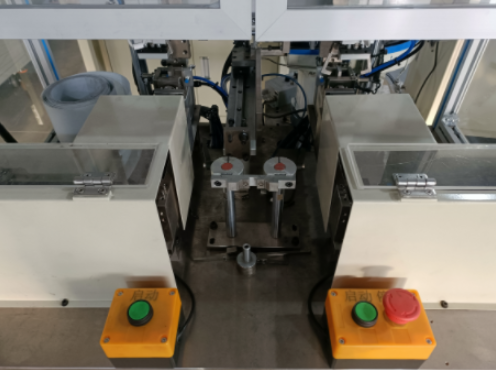What are the common mechanical failures and solutions for DC motor motor semi-automatic spring brush machine?
The common mechanical failures and solutions of DC motor motor semi-automatic spring brush machine are as follows:
1、Brush failure
Excessive wear of brushes: after long-term use, the friction between brushes and commutator will lead to smaller brush size and shorter bristles, which will affect the motor's electrical conductivity and commutation effect, and make the motor speed unstable, power down or even unable to operate normally. It is necessary to replace the brushes in time with new brushes of the same size as the prototype.
Poor brush contact: there may be oil, dust, oxidized layer and other impurities between brushes and commutator, or insufficient brush spring pressure, brush jamming in the brush grip, etc., resulting in increased contact resistance and sparks, which will seriously make the motor unable to start or run abnormally. The solution is to use fine sandpaper to gently grind the contact surface of the brush and commutator to remove impurities and oxidized layer, and then wipe it clean with a clean cloth; check the elasticity of the brush spring, and replace the spring if necessary; adjust the clearance between the brush grip and the brush, so that the brush can slide freely in the brush grip.
2、Spring related faults
Insufficient spring elasticity: after a long time of use, the spring may be fatigued and deformed, resulting in insufficient pressure on the brushes, making the contact between the brushes and the commutator unstable, generating sparks or causing the motor to fail to work normally. The spring should be replaced with a new one to ensure that the spring force meets the requirements. Generally, the spring pressure of the brushes is between 150 and 250gf/cm² which is more suitable3.
Broken springs: This will directly cause the brushes to be unable to maintain good contact with the commutator, causing the motor to break down and fail to operate. It is necessary to replace the damaged spring in time.

3、Commutator failure
Commutator surface wear: the commutator in the long-term friction process with the brush, the surface may appear wear, scratches, unevenness, etc., affecting the brush and commutator contact quality, resulting in increased spark, motor vibration and other issues. If the wear is light, use fine sandpaper to grind and polish the surface of the commutator; if the wear is serious and there are obvious unevenness or grooves, it is necessary to replace the commutator with a new one.
Short circuit between the commutator plates: the insulation layer between the commutator plates may be damaged due to overheating, moisture, impurities and other reasons, resulting in a short circuit between the plates, so that the motor runs with abnormal noise, unstable speed, excessive sparks and other phenomena. Need to use insulation resistance meter to check the insulation resistance between the commutator sheet, find out the short-circuit point, clean up the debris between the sheet and conductive material, if the insulation layer is seriously damaged, it is necessary to replace the commutator or repair the insulation layer.
4、Bearing failure
Bearing wear: bearings in the motor operation process to withstand large loads, long-term use is easy to wear, resulting in motor rotor rotation is not flexible, abnormal noise, vibration increase and other issues. It is necessary to replace the worn bearings in time.
Bearing overheating: It may be caused by insufficient bearing lubrication, too tight bearing installation, overloading of the motor and other reasons. You should check the lubrication of the bearings, supplement or replace the grease in time; adjust the mounting clearance of the bearings to meet the requirements; check the load of the motor to avoid overload operation.
5、Other mechanical failure
Motor vibration: it may be caused by motor rotor imbalance, loose motor foot, improper installation of coupling or drive belt. Need to rotor dynamic balance calibration; check and tighten the motor foot of the set screws; check the coupling or drive belt installation, to ensure that it is firmly connected, good concentricity.
Rotor and stator friction: may be due to motor bearing wear, uneven air gap, rotor shaft bending and other reasons lead to small gap between the rotor and stator, friction occurs. It is necessary to check the bearings and replace the worn bearings; adjust the air gap between the stator and rotor to make it even; check the bending of the rotor shaft, if the bending is serious, it is necessary to straighten or replace the rotor shaft.
※ If you still can't solve the problem by the above ways and means, please contact the technical specialist of Xinhui Electromechanical Equipment Co., Ltd. through the page chat tool to seek help.







